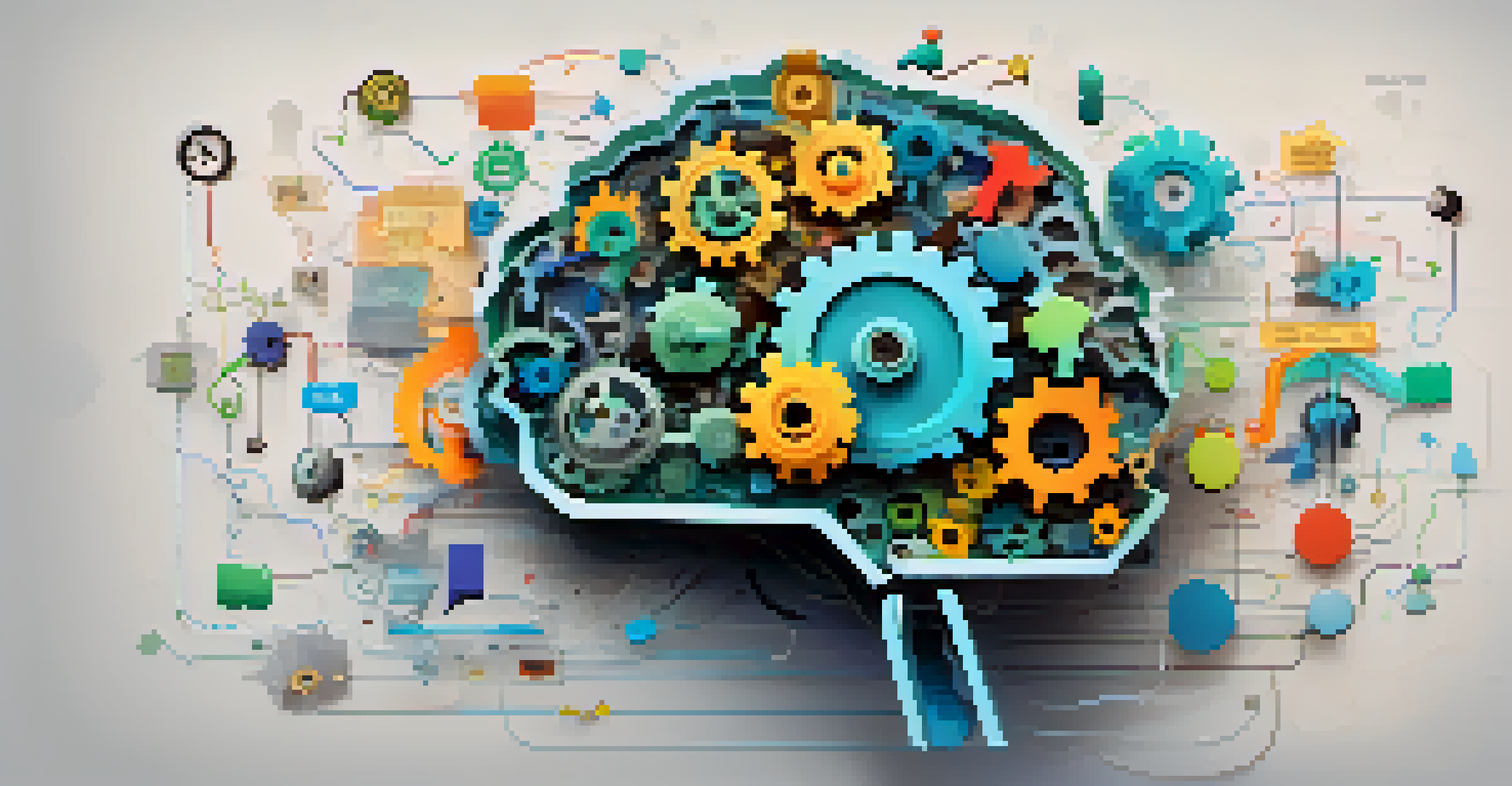The Role of Working Memory in Cognitive Load Management

What is Working Memory and Why It Matters
Working memory is like a mental workspace where we hold and manipulate information temporarily. It’s crucial for tasks that require reasoning, comprehension, and learning. Think of it as a whiteboard where you can jot down ideas and calculations before solving a problem.
Working memory is the ability to hold and manipulate information in our minds, which is essential for reasoning and learning.
This capacity is limited, which means we can only keep a certain number of items active in our mind at once. For instance, trying to remember a long list of groceries while shopping can quickly overwhelm this space. Understanding its limitations helps us find strategies to manage cognitive load effectively.
In today’s fast-paced world, maintaining a clear working memory is essential. It allows us to process information efficiently, make decisions, and learn new skills without feeling overloaded. This is particularly important in academic and professional settings where multitasking is common.
Cognitive Load: What It Is and How It Affects Us
Cognitive load refers to the amount of mental effort being used in the working memory. There are three types: intrinsic, extraneous, and germane load. Each type affects how well we can learn or perform tasks, making it vital to understand their impact.

Intrinsic load is the inherent difficulty of the material being learned, while extraneous load is the unnecessary information that can distract us. Germane load, on the other hand, is the effort put into processing and understanding the information. Balancing these loads is key to effective learning.
Working Memory is Essential for Learning
Working memory acts as a mental workspace that is crucial for reasoning, comprehension, and efficiently processing information.
When cognitive load becomes too high, it can lead to frustration and decreased performance. For example, if you’re learning a new software program while also dealing with constant notifications, your ability to retain information will suffer. This highlights the importance of managing cognitive load to enhance productivity.
The Relationship Between Working Memory and Cognitive Load
Working memory plays a crucial role in managing cognitive load, as it determines how much information we can hold at once. When cognitive load exceeds the capacity of working memory, learning and task performance can falter. This relationship is essential for creating effective educational and training programs.
Cognitive load theory provides a framework for understanding how our working memory capacity affects learning and performance.
Imagine trying to solve a complex math problem while simultaneously listening to music with lyrics. The music can increase your cognitive load, making it harder for your working memory to focus on the task. Understanding this interplay helps us design better environments for learning and working.
By optimizing working memory through various strategies, such as chunking information or reducing distractions, we can enhance our capacity to manage cognitive load. This allows us to learn more effectively and perform tasks with greater ease.
Effective Strategies for Enhancing Working Memory
There are several strategies to enhance working memory, which in turn helps manage cognitive load. One effective method is chunking, where you group information into smaller, manageable units. For example, remembering a phone number is easier when you break it down into segments.
Another strategy involves rehearsal, which is the repetition of information to keep it active in your memory. This could be as simple as repeating a new acquaintance's name to remember it better. Both strategies can significantly improve working memory performance.
Cognitive Load Impacts Performance
Understanding and managing cognitive load is vital, as too much can lead to frustration and decreased ability to learn or perform tasks.
Additionally, minimizing distractions in your environment can also boost your working memory capacity. Creating a quiet workspace or using tools like the Pomodoro technique can help maintain focus, allowing your brain to process information more effectively.
The Impact of Stress on Working Memory and Cognitive Load
Stress can significantly impact working memory and our ability to manage cognitive load. When we're stressed, our brains produce cortisol, which can impair cognitive functions, including memory. This makes it even harder to juggle multiple tasks or learn new information.
For instance, during high-pressure situations like exams or presentations, you might find your mind going blank. This is a direct result of increased cognitive load and decreased working memory capacity. Recognizing this connection is vital for developing coping strategies.
To combat stress and protect working memory, techniques like mindfulness, deep breathing, and regular breaks can be beneficial. These practices help to lower stress levels, allowing for better focus and improved cognitive performance.
Working Memory Training: Myths and Realities
Working memory training has gained popularity, but it’s essential to separate fact from fiction. Some programs claim to drastically improve intelligence through working memory exercises, but research shows mixed results. While training can enhance working memory to some extent, the benefits may not always transfer to other cognitive tasks.
However, engaging in activities that challenge your working memory, like puzzles or memory games, can be beneficial. These exercises can help strengthen your mental agility, making it easier to manage cognitive load in daily life. It’s more about consistent practice than quick fixes.
Stress Negatively Affects Memory
High stress levels can impair working memory by increasing cognitive load, making it harder to focus and retain information.
Ultimately, understanding the limitations and capabilities of working memory can guide us in choosing effective training methods. By setting realistic expectations, we can better appreciate the role of working memory in our cognitive abilities.
Conclusion: Harnessing Working Memory for Better Learning
In summary, working memory is a vital component of cognitive load management. By understanding its role and limitations, we can implement strategies to enhance our memory and reduce cognitive overload. This is not just about learning; it’s about performing better in various aspects of life.
As we navigate through information-rich environments, being mindful of our working memory capacity becomes increasingly important. Whether at school, work, or home, applying these insights can lead to improved productivity and learning outcomes.

Ultimately, by harnessing the power of working memory, we can take control of our cognitive load and foster a more effective learning environment. With the right strategies, we can all become better learners and performers.